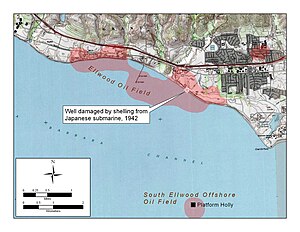Bombardment of Ellwood
| Bombardment of Ellwood | |||||||
|---|---|---|---|---|---|---|---|
| Part of World War II Pacific War | |||||||
 The Ellwood Oil Field and the location of the Japanese attack. | |||||||
| |||||||
| Belligerents | |||||||
|
|
| ||||||
| Commanders and leaders | |||||||
| N/A |
| ||||||
| Strength | |||||||
| N/A | 1 submarine | ||||||
The Bombardment of Ellwood during World War II was a naval attack by a Japanese submarine against United States coastal targets near Santa Barbara, California. Though damage was minimal, the event was key in triggering the West Coast invasion scare and influenced the decision to intern Japanese-Americans. The event also marked the first shelling of the North American mainland during the conflict.
Background
Following the attack on Pearl Harbor, Hawaii, seven Japanese submarines patrolled the American West Coast. They sank several merchant vessels and skirmished twice with U.S. Navy air or sea forces. By the end of December, the submarines had returned to friendly waters to resupply. Many went to Kwajalein and then returned to American waters. Imperial Japanese Navy submarine I-17 was one of these vessels. She displaced 3,654 long tons (3,713 t) when submerged and was 365 ft 6 in (111.40 m) long. Her armament included six 20 in (510 mm) torpedo tubes and 17 torpedos in total. Up top was a 14-cm deck gun. I-17 carried 101 officers and crew under Commander Kozo Nishino.
Nishino's experience included service with the Japanese fleet assigned to Operation Hawaii. Before the war, he commanded a merchant ship which had sailed through the Santa Barbara Channel. Nishino had stopped at the Ellwood Oil Field, where his ship took on oil before returning to Japan. The oil field would be his target during the bombardment. Most of the damage he inflicted was located within 300 m (980 ft) of where Nishino had visited.[1]
Bombardment
About 1900 hours (7:00 pm) on 23 February 1942, I-17 came to a stop off of the Ellwood field. Nishino gave the order to prepare for action. A gun crew quickly took aim at a huge Richfield aviation fuel tank just beyond the beach. Nishino ordered his men to fire at 1915 hours (7:15 pm ), their first rounds landing close to one of the storage facilities. Most of the oilers had gone home for the night, but the few remained on duty heard the first rounds impact. They suspected an internal explosion, but a worker spotted I-17 in the dark. An oiler named G. Brown later described the attacker as so big he thought it was a cruiser or destroyer, until he realized only one gun was firing.
Nishino changed targets to the second storage tank. Brown and the others immediately called the police, but by this time Nishino's men had fired several more rounds.
Wild shells landed on a nearby ranch. One round passed over Wheeler's Inn, and owner Laurence Wheeler called the Santa Barbara County Sheriff's Office. The deputy told Wheeler that warplanes would arrive shortly, but no planes came. A shell did strike the Ellwood Pier, damaging it slightly. A derrick and pump house were destroyed, while a catwalk was damaged. After 20 minutes, Nishino ordered his men to cease fire.
Reverend Arthur Basham observed the submarine from Montecito. He reported that the attacker turned south towards Los Angeles, apparently flashing signal lights to the shore. I-17 continued its voyage, returning to Japan in safety. At least 12 and possibly as many as 25 5.5 in (140 mm) rounds were fired at the Elwood oil installation.
Aftermath
As several people in Santa Barbara reported witnessing "signal lights", a blackout was ordered until the following morning. Nishino's bombardment was reported by news agencies, which caused hundreds to flee. The attack was used as justification for the Federal government's internment of Japanese-Americans (most of them US citizens), which began a week later.
On the night of 24 February, the mysterious Battle of Los Angeles took place, in which coastal defenses responded with hours of anti-aircraft bombardment to reports of the sighting of "enemy aircraft".
Japanese submarines assigned to duty off North America continued to operate against allied shipping. They also conducted the bombardment of Fort Stevens on the Columbia River, and attacked a Canadian lighthouse on Vancouver Island. Despite orders to attack war ships whenever possible, the submarines targeted only merchant vessels and conducted minor bombardments of shore targets. Two air raids were launched from a submarine, in a failed attempt to start a forest fire in southwest Oregon.
See also
- Battle of Los Angeles
- Attack on Orleans
- Bombardment of Fort Stevens
- 1941, a 1979 film by Steven Spielberg, loosely based on the Bombardment of Ellwood
References
This article includes a list of general references, but it lacks sufficient corresponding inline citations. (February 2011) |
Further reading
- Official Chronology of the US Navy in World War II: Chapter V: 1943
- Graham, Otis L.; Bauman, Robert; Dodd, Douglas W.; Geraci, Victor W.; Murray, Fermina Brel. Stearns Wharf: Surviving Change on the California Coast. Graduate Program in Public Historical Studies, University of California, 1994 ISBN 1-883535-15-8
- Parshall, Jon; Hackett, Bob and Kingsepp, Sander. Imperial Japanese Navy Page: HIJMS Submarine I-17: Tabular Record of Movement. Retrieved 7/4/2010
- Webber, Bert. Silent Siege: Japanese Attacks Against North America in World War II, Ye Galleon Press, Fairfield, Washington, 1984 ISBN 0-87770-315-9 (hardcover). ISBN 0-87770-318-3
